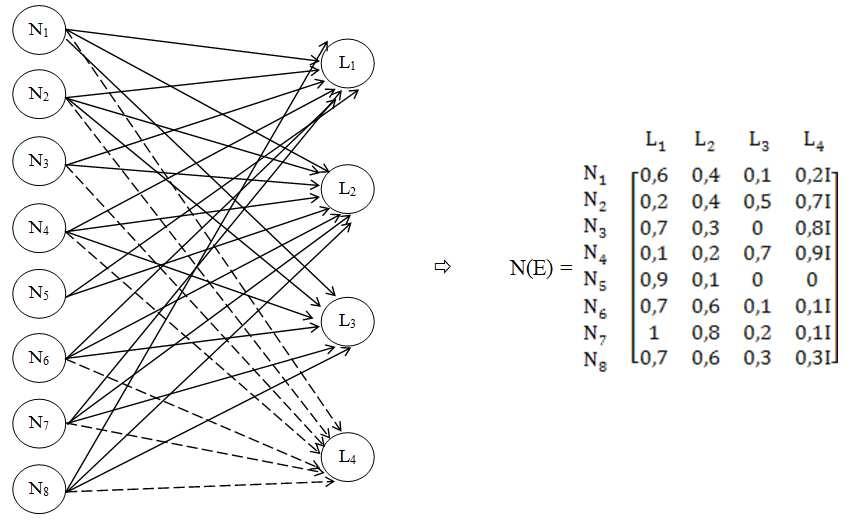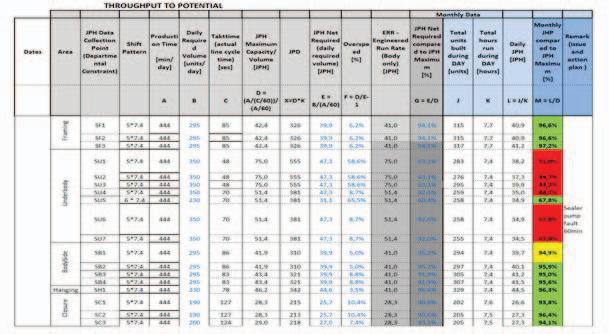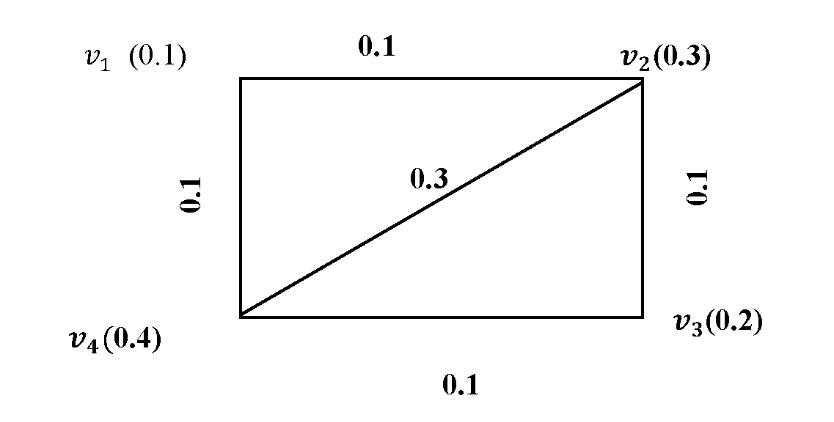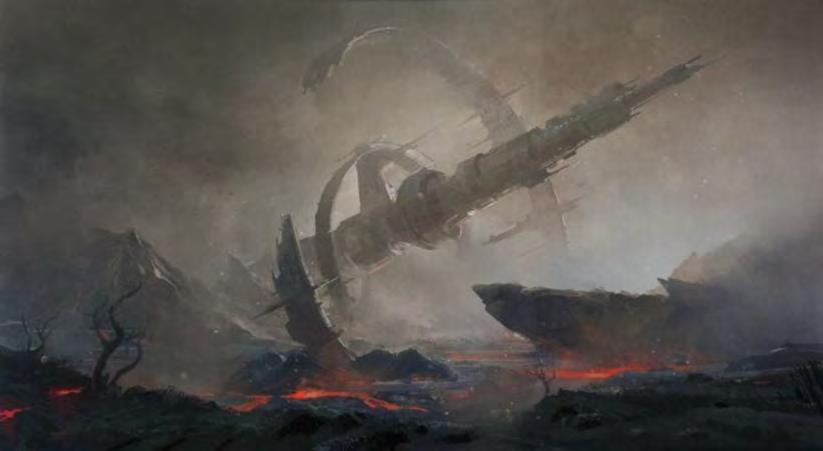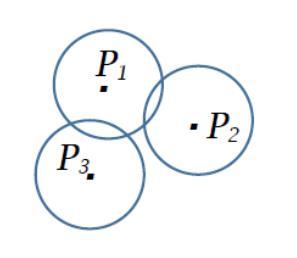
25 minute read
Neutrosophic Systems and Neutrosophic Dynamic Systems
Florentin Smarandache
Advertisement
Florentin Smarandache (2015). Neutrosophic Systems and Neutrosophic Dynamic Systems. Critical Review XI: 7-25
Abstract
In this paper, we introduce for the first time the neutrosophic system and neutrosophic dynamic system that represent new per-spectives in science. A neutrosophic system is a quasi- or (��,��,��)–classical system, in the sense that the neutrosophic system deals with quasi-terms/concepts/attributes, etc. [or (��,��,��)−terms/ concepts/attributes], which are approximations of the classical terms/concepts/attributes, i.e. they are partially true/membership/probable (t%), partially indeterminate (i%), and partially false/nonmember-ship/improbable (f%), where ��,��,��are subsets of the unitary interval [0,1]. {We recall that ‘quasi’ means relative(ly), approximate(ly), almost, near, partial(ly), etc. or mathematically ‘quasi’ means (��,��,��)in a neutrophic way.}
Keywords
neutrosophy, neutrosophics, neutrosophic system, neutrosophic patterns, neutrosophic model, neutrosophic synergy, neutrosophic interactions, neutrosophic complexity, neutrosophic process, neutrosophic cognitive science.
1 Introduction
A system ��in general is composed from a space ℳ, together with its elements (concepts) {����},�� ∈��, and the relationships {ℛ��}, �� ∈��, between them, where �� and �� are countable or uncountable index sets. For a closed system, the space and its elements do not interact with the environment.For an open set, the space or its elements interact with the environment.
2 Definition of the neutrosophic system
A system is called neutrosophic system if at least one of the following occur: a. The space contains some indeterminacy. b. At least one of its elements ��has some indeterminacy (it is not well-defined or not well-known).
c. At least one of its elements x does not 100% belong to the space; we say ��(��,��,��)∈ℳ, with (��,��,��)≠(1,0,0). d. At least one of the relationships ℛ�� between the elements of ℳ is not 100% well-defined (or well-known); we say ℛ��(��,��,��)∈ ��, with (��,��,��)≠(1,0,0). e. For an open system, at least one [ℛ��(��,��,��)] of the system’ s interactions relationships with the environment has some indeterminacy, or it is not well-defined, or not well-known, with (��,��,��)≠(1,0,0).
2.1 Classical system as particular case of neutrosophic system
By language abuse, a classical system is a neutrosophic system with indeterminacy zero (no indeterminacy) at all system’slevels.
2.2 World systems are mostly neutrosophic
In our opinion, most of our world systems are neutrosophic systems, not classical systems, and the dynamicity of the systems is neutrosophic, not classical.
Maybe the mechanical and electronical systems could have a better chance to be classical systems.
3 A simple example of neutrosophic system
Let’s consider a university campus Coronado as a whole neutrosophic system ��, whose space is a prism having a base the campus land and the altitude such that the prism encloses all campus’ buildings, towers, observatories, etc. The elements of the space are people (administration, faculty, staff, and students) and objects (buildings, vehicles, computers, boards, tables, chairs, etc.). A part of the campus land is unused. The campus administration has not decided yet what to do with it: either to build a laboratory on it, or to sell it. This is an indeterminate part of the space. Suppose that a staff (John, from the office of Human Resources) has been fired by the campus director for misconduct. But, according to his co-workers, John was not guilty for anything wrong doing. So, John sues the campus. At this point, we do not know if John belongs to the campus, or not. John’s appurtenance to the campus is indeterminate.
Assume the faculty norm of teaching is four courses per semester. But some faculty are part-timers, therefore they teach less number of courses. If an instructor teaches only one class per semester, he belongs to the campus only partially (25%), if he teaches two classes he belongs to the campus 50%, and if he teaches three courses he belongs to the campus 75%. We may write: Joe (0.25,0,0.75)∈ �� George (0.50,0,0.50)∈ �� and Thom (0.75,0.10,0.25)∈ ��. Thom has some indeterminacy (0.10) with respect to his work in the campus: it is possible that he might do some administrative work for the campus (but we don’t know). The faculty that are full-time (teaching four courses per semester) may also do overload. Suppose that Laura teaches five courses per semester, therefore Laura (1.25,0,0)∈��. In neutrosophic logic/set/probability it’s possible to have the sum of components (��,��,��) different from 1: ��+��+�� >1, for paraconsistent (conflicting) information; ��+��+�� =1, for complete information; ��+��+�� <1, for incomplete information. Also, there are staff that work only ½ norm for the campus, and many students take fewer classes or more classes than the required full-time norm. Therefore, they belong to the campus Coronado in a percentage different from 100%. About the objects, suppose that 50 calculators were brought from IBM for one semester only as part of IBM’s promotion of their new products. Therefore, these calculators only partially and temporarily belong to the campus. Thus, not all elements (people or objects) entirely belong to this system, there exist many ����(��,��,��)∈��, with (��,��,��)≠(1,0,0). Now, let’s take into consideration the relationships. A professor, Frank, may agree with the campus dean with respect to a dean’s decision, may disagree with respect to the dean’s other decision, or may be ignorant with respect to the dean’s various decisions. So, the relationship between Frank and the dean may be, for example:
agreement(0.5,0.2,0.3)
Frank→ dean,i.e.not(1,0,0)agreement. This campus, as an open system, cooperates with one Research Laboratory from Nevada, pending some funds allocated by the government to the campus.
Therefore, the relationship (research cooperation) between campus Coronado and the Nevada Research Laboratory is indeterminate at this moment.
4 Neutrosophic patterns
In a neutrosophic system, we may study or discover, in general, neutrosophic patterns, i.e. quasi-patterns, approximated patterns, not totally working; we say: (��,��,��)−patterns, i.e. t% true, i% indeterminate, and f% false, and elucidate (��,��,��)−principles. The neutrosophic system, through feedback or partial feedback, is (��,��,��)−self-correcting, and (��,��,��)−self-organizing.
5 Neutrosophic holism
From a holistic point of view,the sum of parts of a system may be: 1. Smaller than the whole (when the interactions between parts are unsatisfactory); 2. Equals to the whole (when the interactions between parts are satisfactory); 3. Greater than the whole (when the interactions between parts are super-satisfactory). The more interactions (interdependance, transdependance, hyperdependance) between parts, the more complex a system is. We have positive, neutral, and negative interactions between parts. Actually, an interaction between the parts has a degree of positiveness, degree of neutrality, and degree of negativeness. And these interactions are dynamic, meaning that their degrees of positiveness/neutrality/negativity change in time. They may be partially absolute and partially relative.
6 Neutrosophic model
In order to model such systems, we need a neutrosophic (approximate, partial, incomplete, imperfect) model that would discover the approximate system properties.
7 Neutrosophic successful system
A neutrosophic successful system is a system that is successful with respect to some goals, and partially successful or failing with respect to other goals.
The adaptivity, self-organization, self-reproducing, self-learning, reiteration, recursivity, relationism, complexity and other attributes of a classical system are extended to (��,��,��)−attributes in the neutrosophic system.
8 (��,��,��)−attribute
A (��,��,��)−attribute means an attribute that is t% true (or probable), i% indeterminate (with respect to the true/probable and false/improbable), and f% false/improbable -where t,i,f are subsets of the unitary interval [0,1]. For example, considering the subsets reduced to single numbers, if a neutrosophic system is (0.7, 0.2, 0.3)-adaptable, it means that the system is 70% adaptable, 20% indeterminate regarding adaptability, and 30% inadaptable; we may receive the informations for each attribute phase from different independent sources, that’s why the sum of the neutrosophic components is not necessarily 1.
9 Neutrosophic dynamics
While classical dynamics was beset by dialectics, which brought together an entity 〈A〉 and its opposite 〈antiA〉, the neutrosophic dynamics is beset by trialectics, which brings together an entity 〈A〉 with its opposite 〈antiA〉 and their neutrality 〈neutA〉. Instead of duality as in dialectics, we have tri-alities in our world.
Dialectics failed to take into consideration the neutrality between opposites, since the neutrality partially influences both opposites. Instead of unifying the opposites, the neutrosophic dynamics unifies the triad 〈A〉,〈antiA〉,〈neutA〉. Instead of coupling with continuity as the classical dynamics promise, one has “tripling” with continuity and discontinuity altogether. All neutrosophic dynamic system’s components are interacted in a certain degree, repelling in another degree, and neutral (no interaction) in a different degree. They comprise the systems whose equilibrium is the disechilibrium -systems that are continuously changing. The internal structure of the neutrosophic system may increase in complexity and interconnections, or may degrade during the time. A neutrosophic system is characterized by potential, impotential, and indeterminate developmental outcome, each one of these three in a specific degree.
10 Neutrosophic behavior gradient
In a neutrosophic system, we talk also about neutrosophic structure, which is actually a quasi-structure or structure which manifests into a certain degree; which influences the neutrosophic behavior gradient, that similarly is a behavior quasi-gradient - partially determined by quasi-stimulative effects; one has: discrete systems, continuous systems, hybrid (discrete and continuous) systems.
11 Neutrosophic interactions
Neutrosophic interactions in the system have the form: A B ■ ■
⃡ (��,��,��) Neutrosophic self-organization is a quasi-self-organization. The system’s neutrosophic intelligence sets into the neutrosophic patterns formed within the system’s elements. We have a neutrosophic causality between event E1, that triggers event E2, and so on. And similarly, neutrosophic structure S1 (which is an approximate, not clearly know structure) causes the system to turn on neutrosophic structure S2, and so on. A neutrosophic system has different levels of self-organizations.
12 Potentiality/impotentiality/indeterminacy
Each neutrosophic system has a potentiality/impotentiality/indeterminacy to attain a certain state/stage; we mostly mention herein about the transition from a quasi-pattern to another quasi-pattern. A neutrosophic open system is always transacting with the environment; since always the change is needed. A neutrosophic system is always oscilating between stability, instability, and ambiguity (indeterminacy). Analysis, synthesis, and neutrosynthesis of existing data are done by the neutrosophic system. They are based on system’s principles, antiprinciples, and nonprinciples.
13 Neutrosophic synergy
The Neutrosophic Synergy is referred to partially joined work or partially combined forces, since the participating forces may cooperate in a degree (��), may be antagonist in another degree (��),and may have a neutral interest in joint work in a different degree (��).
14 Neutrosophic complexity
The neutrosophic complex systems produce neutrosophic complex patterns. These patterns result according to the neutrosophic relationships among system’s parts. They are well described by the neutrosophic cognitive maps (NCM), neutrosophic relational maps (NRM), and neutrosophic relational equations (NRE), all introduced by W. B. Vasanttha Kandasamy and F. Smarandache in 2003-2004.
The neutrosophic systems represent a new perspective in science. They deal with quasi-terms [or (��,��,��)−terms], quasi-concepts [or (��,��,��)−concepts], and quasi-attributes [or (��,��,��)−attributes], which are approximations of the terms, concepts, attributes, etc., i.e. they are partially true (��%), partially indeterminate (��%),and partially false (��%). Alike in neutrosophy where there are interactions between 〈A〉, 〈neutA〉, and 〈antiA〉, where 〈A〉 is an entity, a system is frequently in one of these general states: equilibrium, indeterminacy (neither equilibrium, nor disequilibrium), and disequilibrium. They form a neutrosophic complexity with neutrosophically ordered patterns. A neutrosophic order is a quasi or approximate order, which is described by a neutrosophic formalism. The parts all together are partially homogeneous, partially heterogeneous, and they may combine in finitely and infinitely ways.
15 Neutrosophic processes
The neutrosophic patterns formed are also dynamic, changing in time and space. They are similar, dissimilar, and indeterminate (unknown, hidden, vague, incomplete) processes among the parts. They are called neutrosophic processes.
16 Neutrosophic system behavior
The neutrosophic system’s functionality and behavior are, therefore, coherent, incoherent, and imprevisible (indeterminate). It moves, at a given level, from a neutrosophic simplicity to a neutrosophic complexity, which becomes neutrosophic simplicity at the next level. And so on. Ambiguity (indeterminacy) at a level propagates at the next level.
17 Classical systems
Although the biologist Bertalanffy is considered the father of general system theory since 1940, it has been found out that the conceptual portion of the system theory was published by Alexander Bogdanov between 1912-1917 in his three volumes of Tectology.
18 Classical open systems
A classical open system, in general, cannot be totally deterministic, if the environment is not totally deterministic itself. Change in energy or in momentum makes a classical system to move from thermodynamic equilibrium to nonequilibrium or reciprocally. Open classical systems, by infusion of outside energy, may get an unexpected spontaneous structure.
19 Deneutrosophication
In a neutrosophic system, besides the degrees of freedom, one also talk about the degree (grade) of indeterminacy. Indeterminacy can be described by a variable.
Surely, the degrees of freedom should be condensed, and the indetermination reduced (the last action is called “deneutrosophication”). The neutrosophic system has a multi-indeterminate behavior. A neutrosophic operator of many variables, including the variable representing indeterminacy, can approximate and semi-predict the system’s behavior.
20 From classical to neutrosophic systems
Of course, in a bigger or more degree, one can consider the neutrosophic cybernetic system (quasi or approximate control mechanism, quasi information processing, and quasi information reaction), and similarly the neutrosophic chaos theory, neutrosophic catastrophe theory, or neutrosophic complexity theory. In general, when passing from a classical system ���� in a given field of knowledge ℱ to a corresponding neutrosophic system ���� in the same field of knowledge ℱ, one relaxes the restrictions about the system’s space, elements, and relationships, i.e. these components of the system (space, elements, relationships) may contain indeterminacy, may be partially (or totally)
unknown (or vague, incomplete, contradictory), may only partially belong to the system; they are approximate, quasi. Scientifically, we write: ���� =(��,��,��)−����, and we read: a neutrosophic system is a (��,��,��)–classical system. As mapping, between the neutrosophic algebraic structure systems, we have defined neutrosophic isomorphism.
21 Neutrosophic dynamic system
The behavior of a neutrosophic dynamic system is chaotic from a classical point of view. Instead of fixed points, as in classical dynamic systems, one deals with fixed regions (i.e. neighbourhoods of fixed points), as approximate values of the neutrosophic variables [we recall that a neutrosophic variable is, in general, represented by a thick curve –alike a neutrosophic (thick) function]. There may be several fixed regions that are attractive regions in the sense that the neutrosophic system converges towards these regions if it starts out in a nearby neutrosophic state. And similarly, instead of periodic points, as in classical dynamic systems, one has periodic regions, which are neutrosophic states where the neutrosophic system repeats from time to time. If two or more periodic regions are non-disjoint (as in a classical dynamic system, where the fixed points lie in the system space too close to each other, such that their corresponding neighbourhoods intersect), one gets double periodic region, triple periodic region:
and so on: ��−uple periodic region, for �� ≥2. In a simple/double/triple/…/��−uple periodic region the neutrosophic system is fluctuating/oscilating from a point to another point. The smaller is a fixed region, the better is the accuracy.
22 Neutrosophic cognitive science
In the Neutrosophic Cognitive Science, the Indeterminacy “I” led to the definition of the Neutrosophic Graphs (graphs which have: either at least one indeterminate edge, or at least one indeterminate vertex, or both some indeterminate edge and some indeterminate vertex), and Neutrosophic Trees (trees which have: either at least one indeterminate edge, or at least one indeterminate vertex, or both some indeterminate edge and some indeterminate vertex), that have many applications in social sciences. Another type of neutrosophic graph is when at least one edge has a neutrosophic (��,��,��)truth-value. As a consequence, the Neutrosophic Cognitive Maps (Vasantha & Smarandache, 2003) and Neutrosophic Relational Maps (Vasantha & Smarandache, 2004) are generalizations of fuzzy cognitive maps and respectively fuzzy relational maps, Neutrosophic Relational Equations (Vasantha & Smarandache, 2004), Neutrosophic Relational Data (Wang, Smarandache, Sunderraman, Rogatko 2008), etc. A Neutrosophic Cognitive Map is a neutrosophic directed graph with concepts like policies, events etc. as vertices, and causalities or indeterminates as edges. It represents the causal relationship between concepts. An edge is said indeterminate if we don’t know if it is any relationship between the vertices it connects, or for a directed graph we don’t know if it is a directly or inversely proportional relationship. We may write for such edge that (��,��,��) = (0,1,0). A vertex is indeterminate if we don’t know what kind of vertex it is since we have incomplete information. We may write for such vertex that (��,��,��) = (0,1,0). Example of Neutrosophic Graph (edges V1V3, V1V5, V2V3 are indeterminate and they are drawn as dotted):
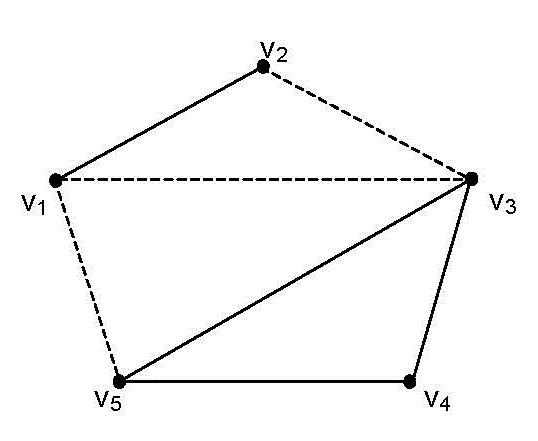
and its neutrosophic adjacency matrix is:
I0I10 00I01 110II 10100 0110I
The edges mean: 0 = no connection between vertices, 1 = connection between vertices, I = indeterminate connection (not known if it is, or if it is not). Such notions are not used in the fuzzy theory. Let’s give an example of Neutrosophic Cognitive Map (NCM), which is a generalization of the Fuzzy Cognitive Maps. We take the following vertices: C1 -Child Labor C2 -Political Leaders C3 -Good Teachers C4 -Poverty C5 -Industrialists C6 -Public practicing/encouraging Child Labor C7 -Good Non-Governmental Organizations (NGOs)
The corresponding neutrosophic adjacency matrix related to this neutrosophic cognitive map is:
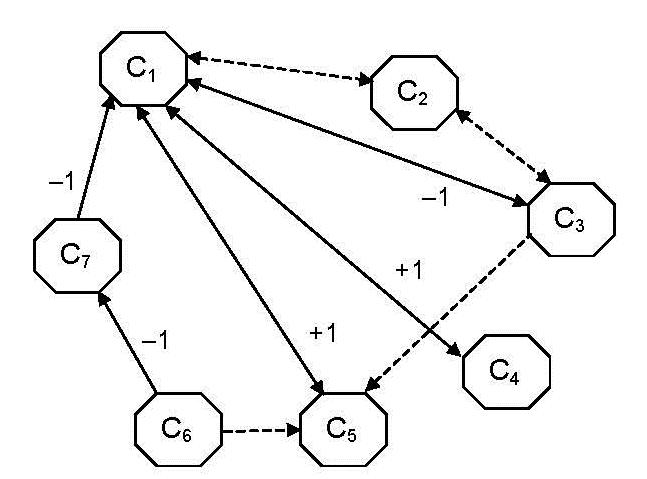
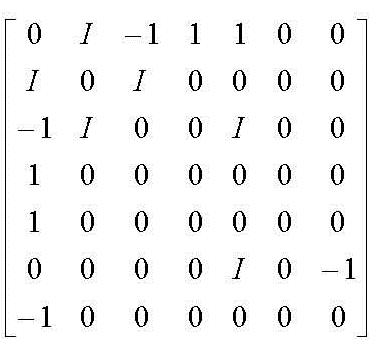
The edges mean: 0 = no connection between vertices, 1 = directly proportional connection, -1 = inversely proportionally connection, and I = indeterminate connection (not knowing what kind of relationship is between the vertices that the edge connects). Now, we give another type of neutrosophic graphs (and trees): An edge of a graph, let's say from A to B (i.e. how A influences B), may have a neutrosophic value (��,��,��), where t means the positive influence of A on B, i means the indeterminate/neutral influence of A on B, and f means the negative influence of A on B. Then, if we have, let's say: ��−>��−>��such that ��−>��has the neutrosophic value (t1, i1, f1) and ��−>��has the neutrosophic value (t2, i2, f2), then ��−>�� has the neutrosophic value (t1, i1, f1)/\(t2, i2. f2), where /\ is the �������� neutrosophic operator. Also, again a different type of graph: we can consider a vertex A as: ��% belonging/membership to the graph, ��% indeterminate membership to the graph, and ��%nonmembership to the graph. Finally, one may consider any of the previous types of graphs (or trees) put together.
23 (��,��,��)−qualitative behavior
We normally study in a neutrosophic dynamic system its long-term (��,��,��)−qualitative behavior, i.e. degree of behavior’s good quality (t), degree of behavior’s indeterminate (unclear) quality (i), and degree of behavior’s bad quality (f). The questions arise: will the neutrosophic system fluctuate in a fixed region (considered as a neutrosophic steady state of the system)? Will the fluctuation be smooth or sharp? Will the fixed region be large (hence less accuracy) or small (hence bigger accuracy)? How many periodic regions does the
neutrosophic system has? Do any of them intersect [i.e. does the neutrosophic system has some ��−uple periodic regions (for �� ≥2), and for how many]?
24 Neutrosophic state
The more indeterminacy a neutrosophic system has, the more chaotic it is from the classical point of view. A neutrosophic lineal dynamic system still has a degree of chaotic behavior. A collection of numerical sets determines a neutrosophic state, while a classical state is determined by a collection of numbers.
25 Neutrosophic evolution rule
The neutrosophic evolution rule decribes the set of neutrosophic states where the future state (that follows from a given current state) belongs to. If the set of neutrosophic states, that the next neutrosophic state will be in, is known, we have a quasi-deterministic neutrosophic evolution rule, otherwise the neutrosophic evolution rule is called quasi-stochastic.
26 Neutrosophic chaos
As an alternative to the classical Chaos Theory, we have the Neutrosophic Chaos Theory, which is highly sensitive to indeterminacy; we mean that small change in the neutrosophic system’s initial indeterminacy produces huge perturbations of the neutrosophic system’s behavior.
Similarly, the difficulties in modellingand simulating a Neutrosophic Complex System (also called Science of Neutrosophic Complexity) reside in its degree of indeterminacy at each system’s level. In order to understand the Neutrosophic System Dynamics, one studies the system’s time quasi-delays and internal quasi-feedback thick-loops (that are similar to thick functions ad thick curves defined in the neutrosophic precalculus and neutrosophic calculus). The system may oscillate from linearity to nonlinearity, depending on the neutrosophic time function.
28 Semi-open semi-closed system
Almost all systems are open (exchanging energy with the environment). But, in theory and in laboratory, one may consider closed systems (completely isolated from the environment); such systems can oscillate between closed and open (when they are cut from the environment, or put back in contact with the environment respectively). Therefore, between open systems and closed systems, there also is a semi-open semi-closed system.
29 Neutrosophic system’s development
The system’s self-learning, self-adapting, self-conscienting, self-developing are parts of the system’s dynamicity and the way it moves from a state to another state –asa response to the system internal or external conditions. They are constituents of system’s behavior. The more developed is a neutrosophic system, the more complex it becomes. System’s development depends on the internal and external interactions (relationships) as well. Alike classical systems, the neutrosophic system shifts from a quasidevelopmental level to another. Inherent fluctuations are characteristic to neutrosophic complex systems. Around the quasi-steady states, the fluctuations in a neutrosophic system becomes its sources of new quasidevelopment and quasi-behavior. In general, a neutrosophic system shows a nonlinear response to its initial conditions. The environment of a neutrosophic system may also be neutrosophic (i.e. having some indeterminacy).
30 Dynamic dimensions of neutrosophic systems
There may be neutrosophic systems whose spaces have dynamic dimensions, i.e. their dimensions change upon the time variable. Neutrosophic Dimension of a space has the form (��,��,��),where we are ��% sure about the real dimension of the space, ��%indeterminate about the real dimension of the space, and ��%unsure about the real dimension of the space.
31 Noise in a neutrosophic system
A neutrosophic system’s noise is part of the system’s indeterminacy. A system’s pattern may evolve or dissolve over time, as in a classical system.
32 Quasi-stability
A neutrosophic system has a degree of stability, degree of indeterminacy referring to its stability, and degree of instability. Similarly, it has a degree of change, degree of indeterminate change, and degree of non-change at any point in time. Quasi-stability of a neutrosophic system is its partial resistance to change.
33 (��,��,��)−attractors
Neutrosophic system’s quasi-stability is also dependant on the (��,��,��)−attractor, which ��%attracts,��%its attraction is indeterminate, and ��% rejects. Or we may say that the neutrosophic system (��%,��%,��%)−prefers to reside in a such neutrosophic attractor. Quasi-stability in a neutrosophic system responds to quasi-perturbations. When (��,��,��)→(1,0,0) the quasi-attractors tend to become stable, but if (��,��,��)→(0,��,��),they tend to become unstable. Most neutrosophic system are very chaotic and possess many quasi-attractors and anomalous quasi-patterns. The degree of freedom in a neutrosophic complex system increase and get more intricate due to the type of indeterminacies that are specific to that system. For example, the classical system’s noise is a sort of indeterminacy. Various neutrosophic subsystems are assembled into a neutrosophic complex system.
34 (��,��,��)− repellors
Besides attractors, there are systems that have repellors, i.e. states where the system avoids residing. The neutrosophic systems have quasi-repellors, or (��,��,��)−repellors, i.e. states where the neutrosophic system partialy avoid residing.
In any (classical or neutrosophic) system, at a given time ρ, for each system state τ one can associate a neutrosophic probability, ����(��)=(t,i,f), where t, i, f are subsets of the unit interval [0, 1] such that:
t = the probability that the system resides in τ; i = the indeterminate probability/improbability about the system residing in τ; f = the improbability that the system resides in τ; For a (classical or neutrosophic) dynamic system, the neutrosophic probability of a system’s state changes in the time, upon the previous states the system was in, and upon the internal or external conditions.
36 (��,��,��)−reiterative
In Neutrosophic Reiterative System, each state is partially dependent on the previous state. We call this process quasi-reiteration or (��,��,��)−reiteration. In a more general case, each state is partially dependent on the previous n states, for �� ≥1. This is called n-quasi-reiteration, or ��−(��,��,��)−reiteration. Therefore, the previous neutrosophic system history partialy influences the future neutrosophic system’s states, which may be different even if the neutrosophic system started under the same initial conditions.
37 Finite and infinite system
A system is finite if its space, the number of its elements, and the number of its relationships are all finite. If at least one of these three is infinite, the system is considered infinite. An infinite system may be countable (if both the number of its elements and the number of its relationships are countable), or, otherwise, uncountable.
38 Thermodynamic (��,��,��)−equilibrium
The potential energy (the work done for changing the system to its present state from its standard configuration) of the classical system is a minimum if the equilibrium is stable, zero if the equilibrium is neutral, or a maximum if the equilibrium is unstable. A classical system may be in stable, neutral, or unstable equilibrium. A neutrosophic system may be in quasi-stable, quasi-neutral or quasi-unstable equilibrium, and its potential energy respectively quasi-minimum, quasi-null (i.e. close to zero), or quasi-maximum. {We recall that ‘quasi’ means relative(ly), approximate(ly), almost, near, partial(ly), etc. or mathematically ‘quasi’ means (��,��,��)in a neutrophic way.}
In general, we say that a neutrosophic system is in (��,��,��)−equilibrium, or ��% in stable equilibrium, ��% in neutral equilibrium, and ��% in unstable equilibrium (non-equilibrium). When �� ≫��(f is much greater than t), the neutroophic system gets into deep non-equilibrium and the perturbations overtake the system’s organization to a new organization. Thus, similarly to the second law of thermodynamics, the neutrosophic system runs down to a (��,��,��)−equilibrium state. A neutrosophic system is considered at a thermodynamic (��,��,��)−equilibrium state when there is not (or insignificant) flow from a region to another region, and the momentum and energy are uninformally at (��,��,��)−level.
The potential energy (the work done for changing the system to its present state from its standard configuration) of the classical system is a minimum if the equilibrium is stable, zero if the equilibrium is neutral, or a maximum if the equilibrium is unstable. In a neutrosophic system, a (��1,��1, ��1)-cause produces a (��2,��2,��2)-effect. We also have cascading (��,��,��)-effects from a given cause, and we have permanent change into the system. (��,��,��)-principles and (��,��,��)-laws function in a neutrosophic dynamic system. It is endowed with (��,��,��)-invariants and with parameters of (��,��,��)-potential (potentiality, neutrality, impotentiality) control.
40 (��,��,��)−holism
A neutrosophic system is a (��,��,��)−holism, in the sense that it has a degree of independent entity (t) with respect to its parts, a degree of indeterminate (i) independent-dependent entity with respect to its parts, and a degree of dependent entity (f) with respect to its parts.
41 Neutrosophic soft assembly
Only several ways of assembling (combining andarranging) the neutrosophic system’s parts are quasi-stable. The others assemble ways are quasitransitional.
The neutrosophic system development is viewed as a neutrosophic soft assembly. It is alike an amoeba that changes its shape. In a neutrosophic dynamic system, the space, the elements, the relationships are all flexible, changing, restructuring, reordering, reconnecting and so on, due to heterogeneity, multimodal processes, multi-causalities, multidimensionality, auto-stabilization, auto-hierarchization, auto-embodiement and especially due to synergetism (the neutrosophic system parts cooperating in a (��,��,��)−degree).
42 Neutrosophic collective variable
The neutrosophic system is partially incoherent (because of the indeterminacy), and partially coherent. Its quasi-behavior is given by the neutrosophic collective variable that embeds all neutrosophic variables acting into the (��,��,��)−holism.
43 Conclusion
We have introduced for the first time notions of neutrosophic system and neutrosophic dynamic system. Of course, these proposals and studies are not exhaustive.
Future investigations have to be done about the neutrosophic (dynamic or not) system, regarding: the neutrosophic descriptive methods and neutrosophic experimental methods, developmental and study the neutrosophic differential equations and neutrosophic difference equations, neutrosophic simulations, the extension of the classical A-Not-B Error to the neutrosophic form, the neutrosophic putative control parameters, neutrosophic loops or neutrosophic cyclic alternations within the system, neutrosophic degenerating (dynamic or not) systems, possible programs within the neutrosophic system, from neutrosophic antecedent conditions how to predict the outcome, also how to find the boundary of neutrosophic conditions, when the neutrosophic invariants are innate/genetic, what are the relationships between the neutrosophic attractors and the neutrosophic repellors, etc.
References
[1] Ludwig von Bertalanffy, General System Theory: Foundations,
Development, Applications, George Braziller, New York, 1968. [2] Jean Piaget, Genetic Epistemology, New York, W.W. Norton&Co.,
Inc., 1970.
[3] N. Chomski, Language and problems of knowledge,The Managua lectures, MIT Press, Cambdridge, 1988. [4] Erich Jantsch, The Self-organizing universe: scientific and human implications of emerging paradigm of evolution, Pergamon, New York, 1980. [5] Edward J. Beltrami, Mathematics for Dynamic Modeling (second edition), Academic Press, 1988. [6] Florentin Smaradache, Neutrosophy. Neutrosophic Probability,
Set and Logic, Amer. Res. Press, Rehoboth, 105 p. 1998. [7] Florentin Smarandache, Neutrosophic Theory and its
Applications, Collected Papers, Vol. 1, 480 p., EuropaNova, Brussels,
Maps and Neutrosophic Cognitive Maps, Phoenix, 211 p., 2003. [10] W. B. Vasantha Kandasamy, F. Smarandache, Analysis of Social
Aspect of Migrant Labourers Living with HIV/AIDS Using Fuzzy Theory and Neutrosophic Cognitive Maps / With specific reference to Rural
Tamilnadu in India, Phoenix, 471 p., 2004. [11] W. B. Vasantha Kandasamy, F. Smarandache, Fuzzy Relational
Maps & Neutrosophic Relational Maps, Hexis, 301 p., 2004. [12] Haibin Wang, Florentin Smarandache, Rajshekhar Sunderraman, André Rogatko, Neutrosophic Relational Data Models, in “Critical Review” (Society for Mathematics of Uncertainty, Creighton
University), Vol. II, 2008, pp. 19-35. [13] Hojjatollah Farahani, Florentin Smarandache, Lihshing Leigh
Wang, A Comparison of Combined Overlap Block Fuzzy Cognitive Maps (COBFCM) and Combined Overlap Block Neutrosophic Cognitive Map (COBNCM) in Finding the Hidden Patterns and Indeterminacies in
Mathematics of Uncertainty, Creighton University, Omaha, NE, USA, Vol.
X, 2015, pp. 70-84.



